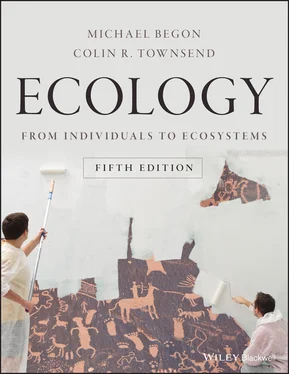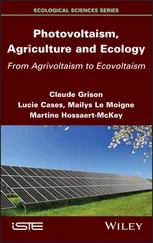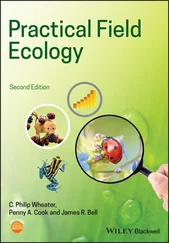3 Chapter 8Table 8.1 Competition between Tribolium confusum and T. castaneum in a range of c...
4 Chapter 10Table 10.1 Cotton rats benefit from an improved quality of their diet. The respon...Table 10.2 Generalist predators can be effective in pest control. A summary of ma...Table 10.3 Factors determining patterns in baboon foraging. The estimated paramet...
5 Chapter 11Table 11.1 Summary statistics for date of first appearance of insects on a ‘corps...
6 Chapter 13Table 13.1 Functions and products of rumen bacteria. A number of the bacterial sp...Table 13.2 Numbers of plant and fungal species forming arbuscular mycorrhiza, ect...Table 13.3 Selected examples of anticancer activity of lichen secondary metabolit...
7 Chapter 14Table 14.1 Key factor (or key phase) analysis for wood frog populations from thre...Table 14.2 Key factor analysis and λ‐contribution analysis for red deer....
8 Chapter 15Table 15.1 Comparison, based on various literature sources, between aspects of th...Table 15.2 An example of a projection matrix for a particular Silene regia popula...
9 Chapter 18Table 18.1 Seasonal patterns in bare space and species richness on boulders in ea...Table 18.2 Measures of area, perimeter and perimeter: area ratio. Values used for...Table 18.3 Contrasting features of three mangrove species. Initial size, and grow...Table 18.4 Reoccupation patterns of reef fish after a resident dies. Numbers of i...
10 Chapter 19Table 19.1 The slopes of species–area relationships are typically steeper for isl...Table 19.2 Activities permitted or prohibited for different levels of protection ...
11 Chapter 20Table 20.1 Net primary production (NPP) per year for major biomes and for the pla...
12 Chapter 21Table 21.1 Global mean (± SE) carbon pools and fluxes in managed and unmanaged fo...Table 21.2 Sources of nitrogen for three continental shelf areas. Atmospheric dep...
13 Chapter 22Table 22.1 Critical earth‐system processes, their control variables, proposed pla...
1 Chapter 1 Figure 1.1 The fathers of evolution. (a) Charles Darwin. Detail from paintin... Figure 1.2 At a given temperature, tadpoles from higher latitudes developed ... Figure 1.3 Local adaptation of rare sapphire rockcress plants. When plants o... Figure 1.4 Meta‐analyses reveal generalities about local adaptation. R... Figure 1.5 The frequency of andromorphs of local damselfly populations in Ja... Figure 1.6 Contrasting ecotypes of the periwinkle Littorina saxatilis from S... Figure 1.7 The frequency of melanic forms of the peppered moth in western Br... Figure 1.8 The orthodox picture of ecological speciation. A uniform species ... Figure 1.9 Many different species of Darwin’s finches have evolved on the Ga... Figure 1.10 Closure of a ring distribution of bulbul morphotypes. (a) Distri... Figure 1.11 Sympatric speciation in the cichlid fish Amphilophus citrinellus... Figure 1.12 Sympatric speciation in Howea palms. Two species of Howea palm o... Figure 1.13 Biodiversity hot spots. Twenty‐five biodiversity hot spots ident... Figure 1.14 Continental drift means that continents that are now separate we... Figure 1.15 Parallel evolution of marsupial and placental mammals. The pairs... Figure 1.16 An evolutionary tree linking 93 species of picture‐winged Drosop... Figure 1.17 Contrasting changes in the distribution of spruce and oak specie... Figure 1.18 Contrasting changes between fossil and current distributions of ... Figure 1.19 Forest species richness is positively related to forest ‘stabili... Figure 1.20 A phylogenetic split bisecting insect and bird biotas into north... Figure 1.21 The invasion of Parthenium weed. This weed is invasive in the co... Figure 1.22 World distribution of the major biomes of vegetation. Figure 1.23 Biomes in relation to rainfall and temperature. The variety of e... Figure 1.24 Raunkiaer’s life forms. The drawings above depict the vari... Figure 1.25 Species traits in streams. Relationships between the representat...
2 Chapter 2 Figure 2.1 Response curves illustrating the effects of a range of environmen... Figure 2.2 The ecological niche in one, two and three dimensions. (a) A nich... Figure 2.3 The use of ordination to facilitate understanding of the multidim... Figure 2.4 Ecological niche modelling. The first step is to characterise a s... Figure 2.5 Modelling the potential range of an invasive starfish. (a) Curren... Figure 2.6 Ordination contrasts the multidimensional niches of native and in... Figure 2.7 Location of fossil bones of the takahe in the South Island of New... Figure 2.8 Exponential effects of temperature on metabolic reactions. (a) Th... Figure 2.9 Effectively linear relationships between rates of growth and deve... Figure 2.10 The temperature–size rule (final size decreases with increasing ... Figure 2.11 The avenues of heat exchange between an ectotherm and its enviro... Figure 2.12 Examples of the thermoneutral zone. (a) Thermostatic heat produc... Figure 2.13 Acclimatisation involves conversion of glycogen to glycerol in a... Figure 2.14 Alfalfa can be selected for improved freezing tolerance. (a) Tol... Figure 2.15 The chilling tolerance of Miscanthus can be transferred to Sacch... Figure 2.16 Features of the El Niño–Southern Oscillation (ENSO) and the Nort... Figure 2.17 The abundance of three‐year‐old cod, Gadus morhua, in the Barent... Figure 2.18 The treelines (high‐altitude limits of forest cover) of the worl... Figure 2.19 Warm boundary limits of nine Australian fish species are correla... Figure 2.20 Geographic variation in thermal tolerances. (a) Terrestrial ecto... Figure 2.21 Niches of cover crops in terms of temperature and base water pot... Figure 2.22 Metabolic expenditure in relation to salinity for two shrimp spe... Figure 2.23 General zonation scheme for the seashore determined by relative ... Figure 2.24 Individuals of Platynympha longicaudata in a polluted site are m... Figure 2.25 Acid emissions have been decreasing in Europe since 1970 while t... Figure 2.26 Atmospheric concentrations of CO 2during the past 420 000 years a... Figure 2.27 Total annual anthropogenic greenhouse gas (GHG) emissions from 1... Figure 2.28 Annual land and ocean surface temperature anomalies and sea‐leve...
3 Chapter 3 Figure 3.1 Global map of the solar radiation absorbed annually in the earth–... Figure 3.2 Levels of solar radiation vary over time and space and with depth... Figure 3.3 The spectral distribution of radiation changes with depth as show... Figure 3.4 The response of photosynthesis to radiation intensity in various ... Figure 3.5 Bioengineering of photoprotection can improve crop plant performa... Figure 3.6 Variation in light quality in lakes can give rise to different co... Figure 3.7 The compensation point is higher in taller plants. (a) The declin... Figure 3.8 Photosynthetic capacity increases with leaf nitrogen content. The... Figure 3.9 Sun and shade leaves and plants vary in their capacities and comp... Figure 3.10 Variations in the behaviour and properties of sun and shade leav... Figure 3.11 Alternative strategies for combining photosynthesis and water co... Figure 3.12 Field capacity and the permanent wilting point in soil in relati... Figure 3.13 Roots as foragers. (a) The root system developed by a plant of w... Figure 3.14 The change in atmospheric CO 2concentration with height in a fore... Figure 3.15 Concentrations of CO 2vary, variably, with depth in Estonian lake... Figure 3.16 Aquatic plants may be limited in their photosynthetic ability by... Figure 3.17 Effects of temperature and precipitation on the proportional con... Figure 3.18 Agave species (CAM plants) exhibit high productivity due to thei... Figure 3.19 Bioengineering of a gene from cyanobacteria into soybean increas... Figure 3.20 Estimates of atmospheric CO 2concentrations over the past 600 mil... Figure 3.21 Photosynthetic activity is increased by enhanced CO 2concentratio... Figure 3.22 Stomatal conductance is decreased by enhanced CO 2concentrations,... Figure 3.23 Effects of elevated CO 2concentrations on C 3and C 4grasses are rev... Figure 3.24 Effects of CO 2enhancement on plant protein concentrations with p... Figure 3.25 Periodic table of the elements showing those that are essential ... Figure 3.26 The mineral compositions of different plants and plant parts are... Figure 3.27 Enrichment commonly leads to a switch from oxygen to (anaerobic)... Figure 3.28 Methane production increases when permafrost thaws, and its micr... Figure 3.29 The composition of various plant parts and of the bodies of anim... Figure 3.30 Resource‐dependent growth isoclines. Each of the growth is... Figure 3.31 Metabolic scaling: the relationship between metabolic rate (Y, w... Figure 3.32 Schematic representation of the two main approaches to the relat... Figure 3.33 Relationships between metabolic rate and body mass for heterotro... Figure 3.34 The allometric exponent of metabolism in plants decreases with p...
Читать дальше












